Measuring and Evaluating the Speed and the Physical Characteristics of Fishes Based on Video Processing
Abstract
1. Introduction
- Avoid traditional methods for determining the physical characteristics of fish;
- Solve the issue regarding the expense of current solutions for the online monitoring of the physical characteristics of fish.
- The development of an online and continuous low-cost tool for monitoring fish velocity;
- An investigation of the quantitative characteristics of fish, including the length and diameter of the body;
- An identification of the relations between fish body length and velocity;
- An identification of the relations between fish velocity under normal and feeding conditions.
2. Related Work
3. Materials and Methods
3.1. Data Collection
3.2. Image Processing
3.3. Artificial Neural Network Definition
3.4. Diagnosis Assessment Criteria
4. Results
4.1. Statistical Analyses under Two Conditions of Normal and Feeding
4.2. Correlation between Normal and Feeding Conditions for Fish
4.3. Velocity Prediction Model of Fish by Using ANN under Normal Conditions
4.4. Discussion
5. Conclusions
Author Contributions
Funding
Data Availability Statement
Acknowledgments
Conflicts of Interest
References
- Akbarzadeh, A.; Karami, M.; Nezami, S.A.; Amiri, B.M.; Khara, H.; Eagderi, S. A comparative study of morphometric and meristic characters of pikeperch Sander lucioperca (L.) in Iranian waters of Caspian Sea and Aras Dam Lake. Iran. J. Biol. 2009, 22, 535–545. [Google Scholar]
- Amraei, S.; Mehdizadeh, S.A.; Sallary, S. Application of computer vision and support vector regression for weight prediction of live broiler chicken. Eng. Agric. Environ. Food 2017, 10, 266–271. [Google Scholar] [CrossRef]
- Bagheri, T.; Hedayati, A.A.; Abdoli, A. Study of some morphometric measurements, meristic traits, age and growth structure of Borbus grypus in Dalaki river. Iran Biol. Mag. 2010, 23, 389–396. [Google Scholar]
- Bai, Y.X.; Zhang, S.H.; Fan, Z.; Liu, X.Y.; Zhao, X.; Feng, X.-Z.; Sun, M.Z. Automatic multiple zebrafish tracking based on improved HOG features. Sci. Rep. 2018, 8, 10884. [Google Scholar] [CrossRef] [PubMed]
- Behzadi, B.; Borghei, A.M.; Javadi, A.; Minaei, S.; Almassi, M. Image Based Method to Identify Trout Fish Biometric Characteristics and Mapping Growth Curve Trout Fish by Digital Image Analysis under Laboratory Conditions. Agric. Mech. Syst. Res. 2019, 20, 113–128. [Google Scholar]
- Date, K.; Nagi, R. GPU-accelerated Hungarian algorithms for the linear assignment problem. Parallel Comput. 2016, 57, 52–72. [Google Scholar] [CrossRef]
- De Oliveira Barreiros, M.; De Oliveira Pantas, D.; De Oliveira Silva, L.C.; Ribeiro, S.; Barros, A.K. Zebrafish tracking using YOLOv2 and Kalman filter. Sci. Rep. 2021, 11, 3219. [Google Scholar] [CrossRef]
- Delcourt, J.; Denoël, M.; Ylieff, M.; Poncin, P. Video multitracking of fish behavior: A synthesis and future perspectives. Fish Fish. 2013, 14, 186–204. [Google Scholar] [CrossRef]
- Delcourt, J.; Ylieff, M.; Bolliet, V.; Poncin, P.; Bardonnet, A. Video tracking in the extreme: A new possibility for tracking nocturnal underwater transparent animals with fluorescent elastomer tags. Behav. Res. Methods 2011, 43, 590–600. [Google Scholar] [CrossRef]
- Ding, C.; Wang, S.; Liu, N.; Xu, K.; Wang, Y.; Liang, Y. REQ-YOLO: A resource-aware, efficient quantization framework for object detection on FPGAS. In Proceedings of the ACM/SIGDA International Symposium on Field-Programmable Gate Arrays, Monterey, CA, USA, 24–26 February 2019. [Google Scholar] [CrossRef]
- FAO. The State of World Fisheries and Aquaculture; Food and Agricultural Organization of the United Nations: Pasaden, CA, USA, 2020. [Google Scholar]
- Garcia, M.; Sendra, S.; Lloret, G.; Lloret, J. Monitoring and control sensor system for fish feeding in marine fish farms. IET Commun. 2010, 5, 1682–1690. [Google Scholar] [CrossRef]
- Garcia-Magarino, I.; Lacuesta, R.; Lloret, J. ABS-Fish count: An agent-based simulator of underwater sensors for measuring the amount of fish. Sensors 2017, 17, 2606. [Google Scholar] [CrossRef] [PubMed]
- Hassan, W.; Fore, M.; Urke, H.A.; Ulvund, J.B.; Bendiksen, E.; Alfredsen, J.A. New concept for measuring swimming speed of free-ranging fish using acoustic telemetry and Doppler analysis. Biosyst. Eng. 2022, 220, 103–113. [Google Scholar] [CrossRef]
- Heidari, S.; Ghaleh, E.M.; Rabbani, H.; Vesali, F. Determining of Some Water Quality Parameters in Fish Pond Using Image Processing. Iran. J. Biosyst. Eng. 2019, 50, 607–614. [Google Scholar]
- Hvas, M.; Oppedal, F. Sustained swimming capacity of Atlantic salmon. Aquac. Environ. Interact. 2017, 9, 361–369. [Google Scholar] [CrossRef]
- Hvas, M.; Folkedal, O.; Solstorm, D.; Vågseth, T.; Fosse, J.O.; Gansel, L.C.; Oppedal, F. Assessing swimming capacity and schooling behaviour in farmed Atlantic salmon Salmo salar with experimental push-cages. Aquaculture 2017, 473, 423–429. [Google Scholar] [CrossRef]
- Izgi, E.; Oztopal, A.; Yerli, B.; Kaymak, M.K.; Sahin, A.D. Short-mid-term solar power prediction by using artificial neural networks. J. Int. Sol. Energy 2012, 86, 725–733. [Google Scholar] [CrossRef]
- Jeong, S.J.; Yang, Y.S.; Lee, K.; Kang, J.G.; Lee, D.G. Vision-based automatic system for non-contact measurementof morphometric characteristics of flatfish. J. Electr. Eng. Technol. 2013, 8, 1194–1201. [Google Scholar] [CrossRef]
- Mirat, O.; Sternberg, J.R.; Severi, K.E.; Wyart, C. Zebra Zoom: An automated program for high-throughput behavioral analysis and categorization. Front. Neural Circuits 2013, 7, 107. [Google Scholar] [CrossRef]
- Mirhaji, H.; Soleymani, M.; Asakereh, A.; Mehdizadeh, S.A. Fruit détection and load estimation of an orange orchard using the YOLO models through simple approches in different Imaging and illumination conditions. Comput. Electron. Agric. 2021, 191, 106533. [Google Scholar] [CrossRef]
- Moreno, A.; Gilabert, M.A.; Martinez, B. Mapping daily global solar irradiation over Spain: A comparative study of selected approaches. J. Int. Sol. Energy 2011, 85, 2072–2084. [Google Scholar] [CrossRef]
- Parra, L.; Sendra, S.; Garcia, L.; Lloret, J. Design and deployment of low-cost sensors for monitoring the water quality and fish behavior in aquaculture tanks during the feeding process. Sensors 2018, 18, 750. [Google Scholar] [CrossRef] [PubMed]
- Pérez-Escudero, A.; Vicente-Page, J.; Hinz, R.C.; Arganda, S.; de Polavieja, G.G. idTracker: Tracking individuals in a group by automatic identification of unmarked animals. Nat. Methods 2014, 11, 743–748. [Google Scholar] [CrossRef]
- Pourmozaffar, S.; Jabaleh, A.; Safiyari, H.; Rameshi, H.; Jahromi, S.T.; Gozari, M.; Zahedi, M. Evaluation of Morphometric changes of rainbow Trout (Oncorhynchus mykiss) using image processing method (IPM). Ecol. Water Resour. J. 2019, 4, 28–35. [Google Scholar]
- Qian, Z.-M.; Cheng, X.E.; Chen, Y.Q. Automatically detect and track multiple fish swimming in shallow water with frequent occlusion. PLoS ONE 2014, 9, e106506. [Google Scholar] [CrossRef] [PubMed]
- Redmon, J.; Farhadi, A. YOLO9000: Better, faster, stronger. In Proceedings of the IEEE Conference on Computer Vision and Pattern Recognition (CVPR), Honolulu, HI, USA, 21–26 July 2017; pp. 6517–6525. [Google Scholar]
- Remen, M.; Solstorm, F.; Bui, S.; Pascal, K.; Vagseth, T.; Solstorm, D.; Hvas, M.; Oppedal, F. Critical swimming speed in groups of Atlantic salmon Salmo salar. Aquac. Environ. Interact. 2016, 8, 659–664. [Google Scholar] [CrossRef]
- Siriani, A.L.R.; Kodaira, V.; Mehdizadeh, S.A.; De Alencar Nass, I.; de Moura, D.J.; Pereira, D.F. Detection and tracking of chickens in low-light images using YOLO network and Kalman filter. Neural Comput. Appl. 2022, 34, 21987–21997. [Google Scholar] [CrossRef]
- Romero-Ferrero, F.; Bergomi, M.G.; Hinz, R.C.; Heras, F.J.H.; de Polavieja, G.G. Idtracker.ai: Tracking all individuals in small or large collectives of unmarked animals. Nat. Methods 2019, 16, 179–182. [Google Scholar] [CrossRef] [PubMed]
- Safiyari, H.; Jafari, A.; Raoufat, M.H.; Nassiri, S.M. Feasibility of sorting the tigertooth croaker (Otolithes ruber) and silver pomfret (Pampus argenteus) fishes using computer vision technology. J. Fish. (Iran. J. Nat. Resour.) 2015, 68, 267–286. [Google Scholar]
- Sanuade, O.A.; Hassan, A.M.; Akanji, A.O.; Olaojo, A.A.; Oladunjoye, M.A.; Abdulraheem, A. New empirical equation to estimate the soil moisture content based on thermal properties using machine learning techniques. Arab. J. Geosci. 2020, 13, 377. [Google Scholar] [CrossRef]
- Sarkar, U.K.; Khan, G.E.; Dabas, A.; Pathak, A.K.; Mir, J.I.; Rebello, S.C.; Pal, A.; Singh, S.P. Length-weight relationship and condition factor of selected freshwater fish species found in river Ganga, Gomti and Rapti, India. J. Environ. Biol. 2013, 34, 951–956. [Google Scholar]
- Singh, L.; Alam, A.; Kumar, V.K.; Kumar, D.; Kumar, P.; Jaffery, Z.A. Design of thermal imaging-based health condition monitoring and early fault detection technique for porcelain insulators using Machine learning. Environ. Technol. Innov. 2021, 24, 102000. [Google Scholar] [CrossRef]
- Torisawa, S.; Kadota, M.; Komeyama, K.; Suzuki, K.; Takagi, T. A digital stereo-video camera system for three-dimensional monitoring of free-swimming Pacific bluefin tuna, Thunnus orientalis, cultured in a net cage. Aquat. Living Resour. 2011, 24, 107–112. [Google Scholar] [CrossRef]
- Turan, C. A note on the examination of morphometric differentiation among fish populations: The truss system. Turk. J. Zool. 1999, 23, 259–264. [Google Scholar]
- Velayatzadeh, M.; Hamidinejad, M. Importance and position of Indian carp grove in the Iranian fishery industry. First Aquat. Sci. Conf. 2012, 50, 272–276. (In Farsi) [Google Scholar]
- Wang, S.H.; Cheng, X.E.; Qian, Z.-M.; Liu, Y.; Chen, Y.Q. Automated planar tracking the waving bodies of multiple zebrafish swimming in shallow water. PLoS ONE 2016, 11, e0154714. [Google Scholar] [CrossRef]
- Wang, X.; Cheng, E.; Burnett, I.S.; Wilkinson, R.; Lech, M. Automatic tracking of multiple zebrafish larvae with resilience against segmentation errors. In Proceedings of the IEEE 15th International Symposium on Biomedical Imaging (ISBI 2018), Washington, DC, USA, 4–7 April 2018; pp. 1157–1160. [Google Scholar] [CrossRef]
- Yao, H.; Duan, Q.; Li, D.; Wang, J. An improved K-means clustering algorithm for fish image segmentation. Math. Comput. Model. 2013, 58, 790–798. [Google Scholar] [CrossRef]
- Zabihi, J.; Nassiri, M.; Jafari, A.A. Estimation of density of trout in fish farm using image processing technique. J. Fish. (Iran. J. Nat. Resour.) 2014, 67, 49–59. [Google Scholar]
- Zhang, L.; Wang, J.; Duan, Q. Downscaling groundwater storage data in China to a 1-km resolution using machine learning methods. Remote Sens. 2020, 13, 523. [Google Scholar] [CrossRef]
- Xu, Z.; Cheng, X.E. Zebrafish tracking using convolutional neural networks. Sci. Rep. 2017, 7, 42815. [Google Scholar] [CrossRef]
- Park, J.H.; Kang, C. A study on enhancement of fish recognition using cumulative mean of Yolo network in underwater video images. J. Mar. Sci. Eng. 2020, 8, 952. [Google Scholar] [CrossRef]
- Anas, D.F.; Jaya, I.; Nurjanah. Designed and implementation of fish freshness detection algorithm using deep learning. IOP Conf. Ser. Earth Environ. Sci. 2021, 944, 012007. [Google Scholar] [CrossRef]
- Zion, B.; Ostrovsky, V.; Karplus, I.; Lidor, G.; Barki, A. Ornamental Fish Mass Estimation by Image Processing; Agricultural Research Organization: Bet Dagan, Israel, 2012. [Google Scholar]
- Zhang, T.; Xu, C.; Yang, M.-H. Multi-task correlation particle filter for robust object tracking. In Proceedings of the IEEE Conference on Computer Vision and Pattern Recognition (CVPR), Honolulu, HI, USA, 21–26 July 2017; pp. 4819–4827. [Google Scholar]
- Salman, A.; Siddiqui, S.A.; Shafait, F.; Mian, A.; Shortis, M.R.; Khurshid, K.; Ulges, A.; Schwanecke, U. Automatic fish detection in underwater videos by a deep neural network-based hybrid motion learning system. Int. Counc. Explor. Sea (ICES) J. Mar. Sci. 2020, 77, 1295–1307. [Google Scholar] [CrossRef]
- Lalabadi, H.M.; Sadeghi, M.; Mireei, S.A. Fish freshness categorization from eyes and gills color feature using multi class artificial neural network and support vector machines. Agric. Eng. 2020, 90, 102076. [Google Scholar]
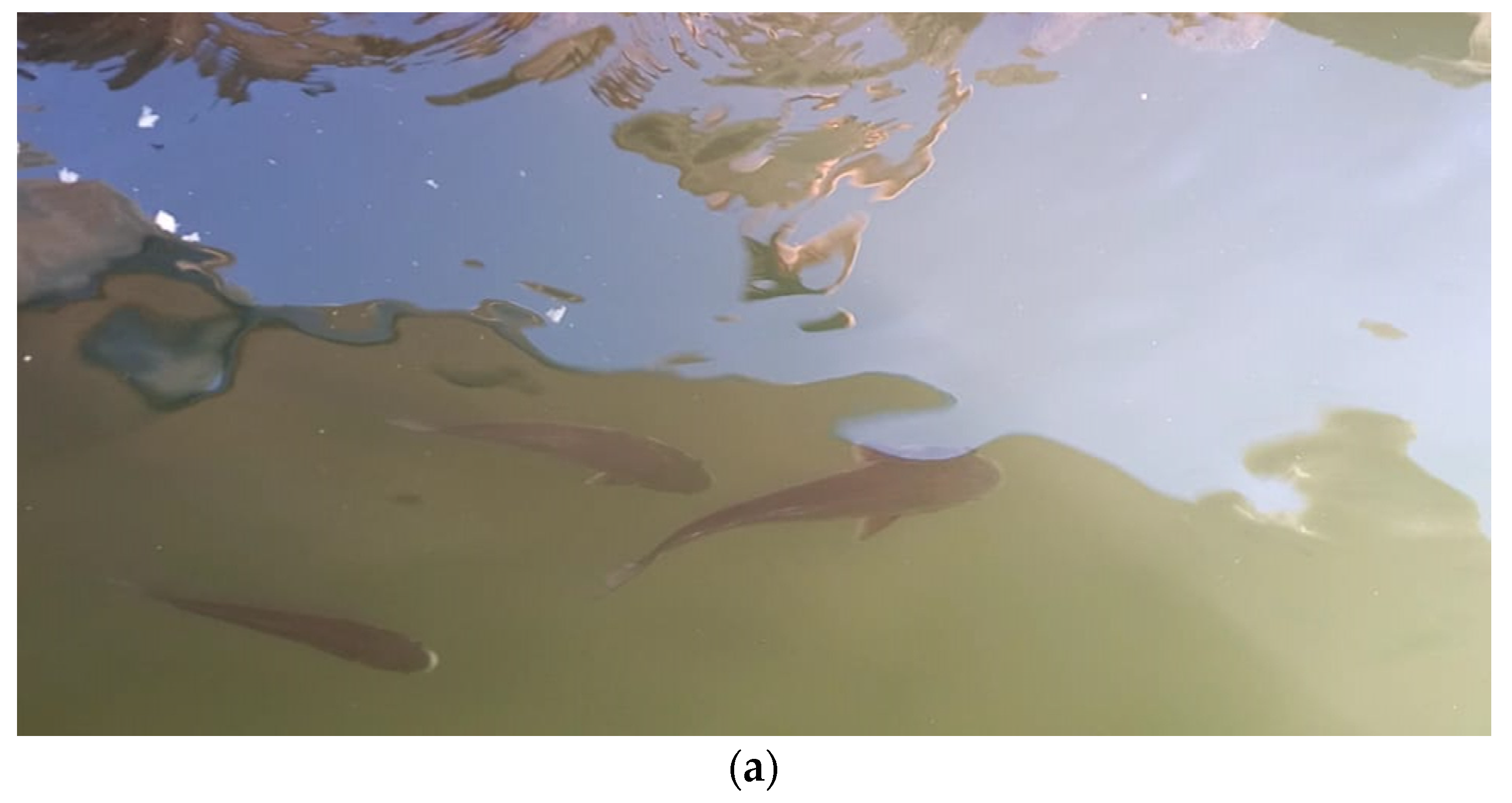


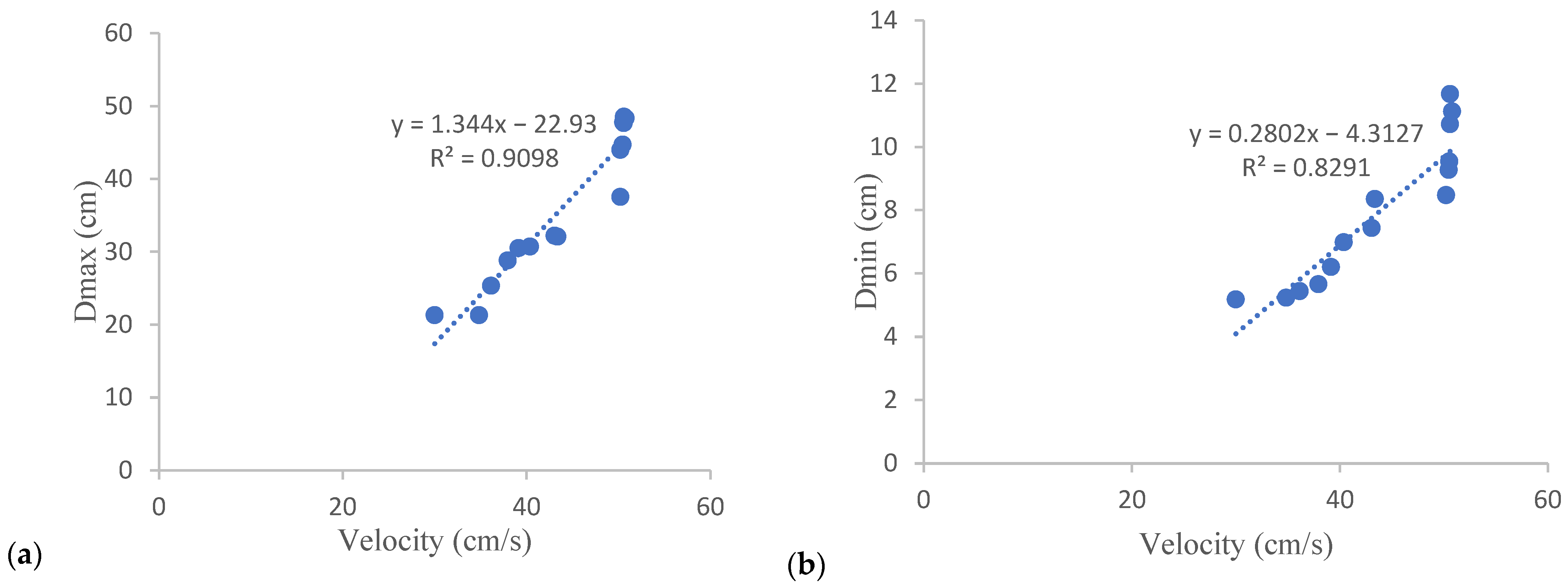

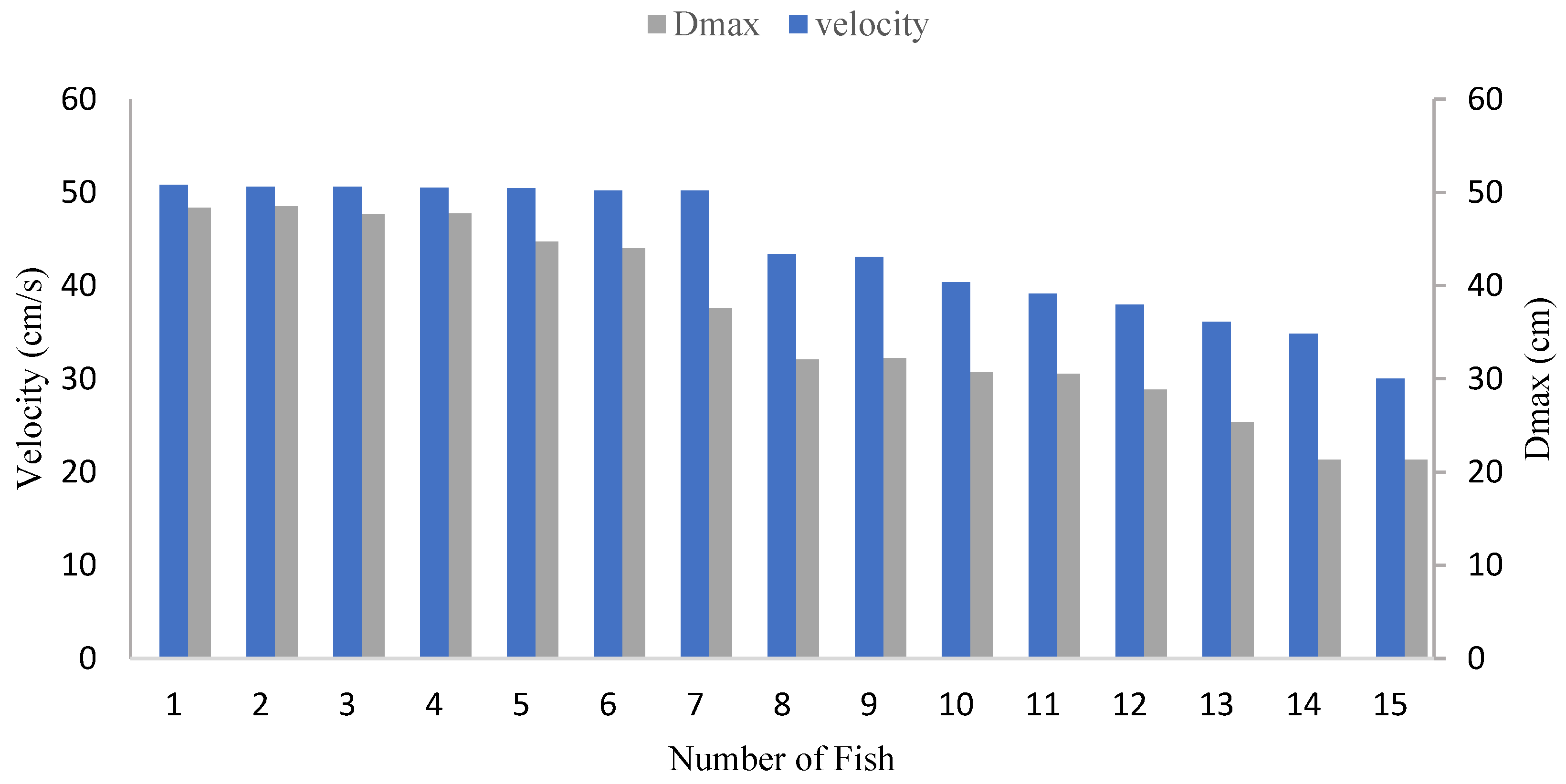
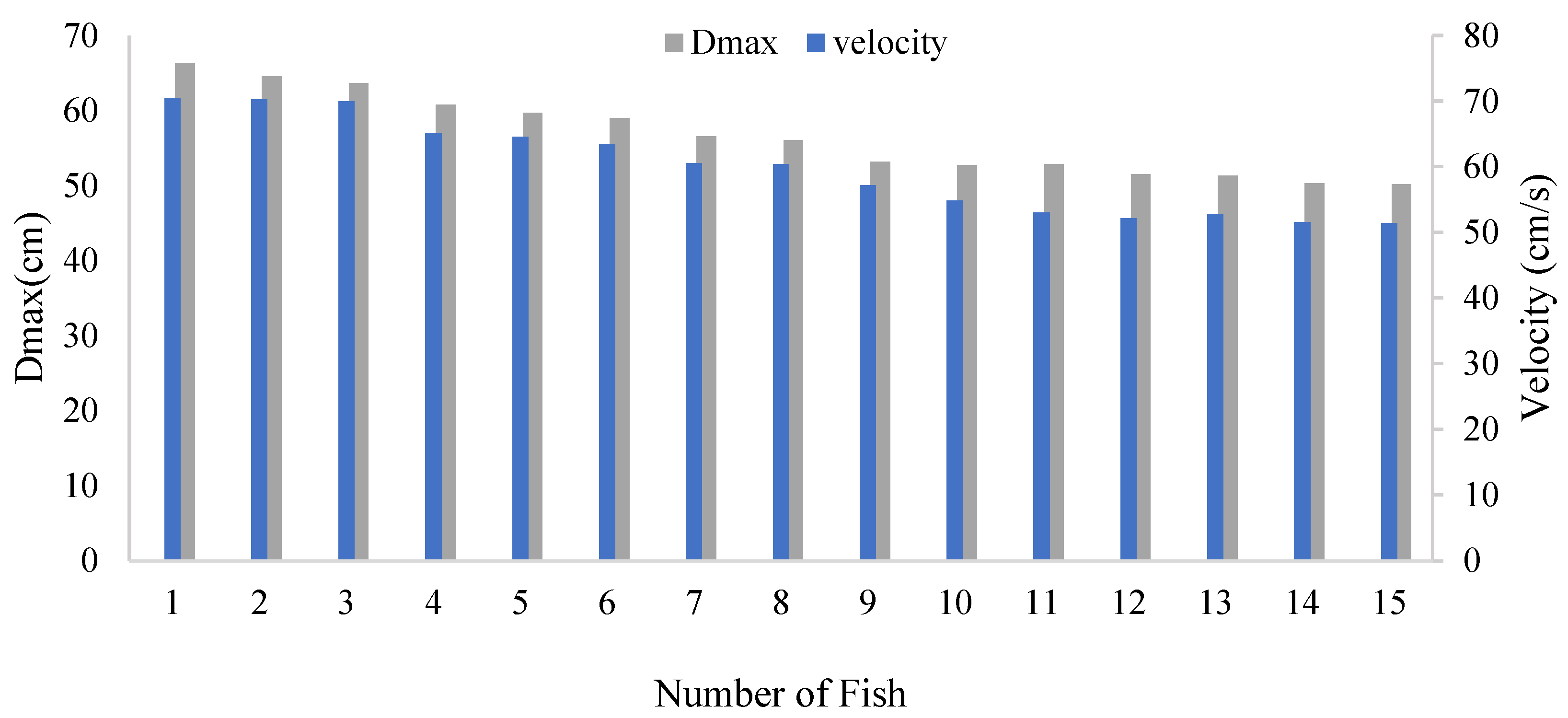
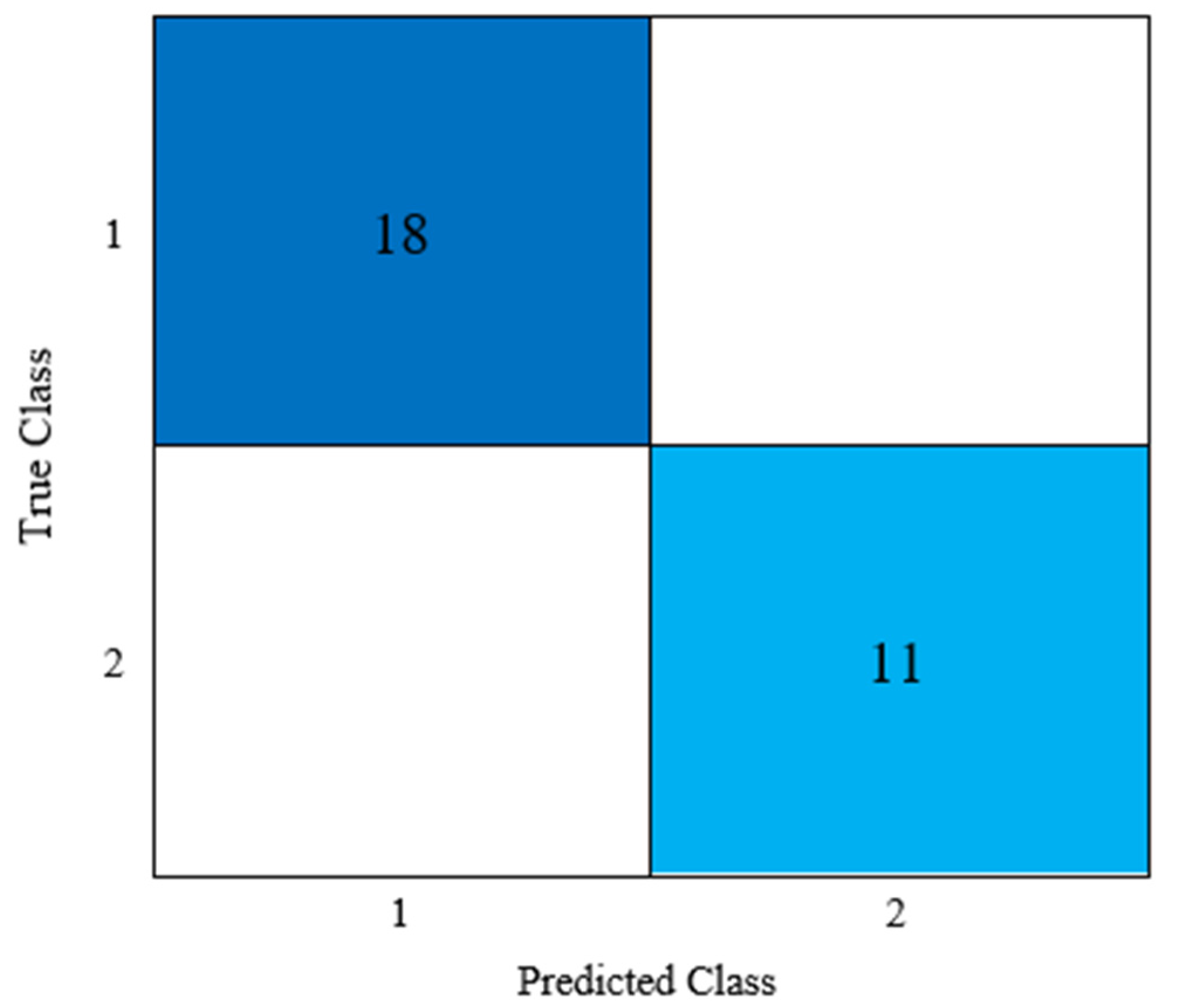
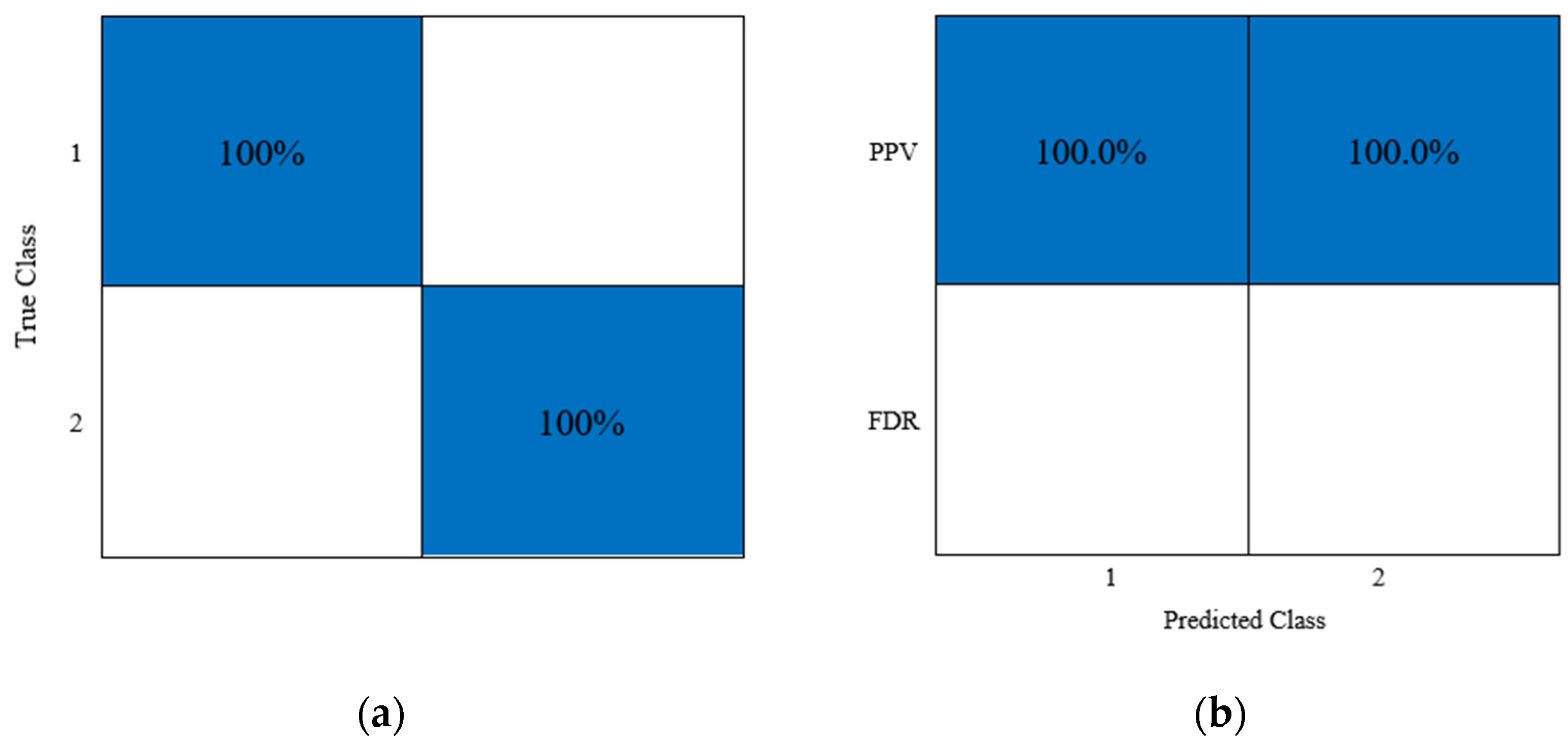
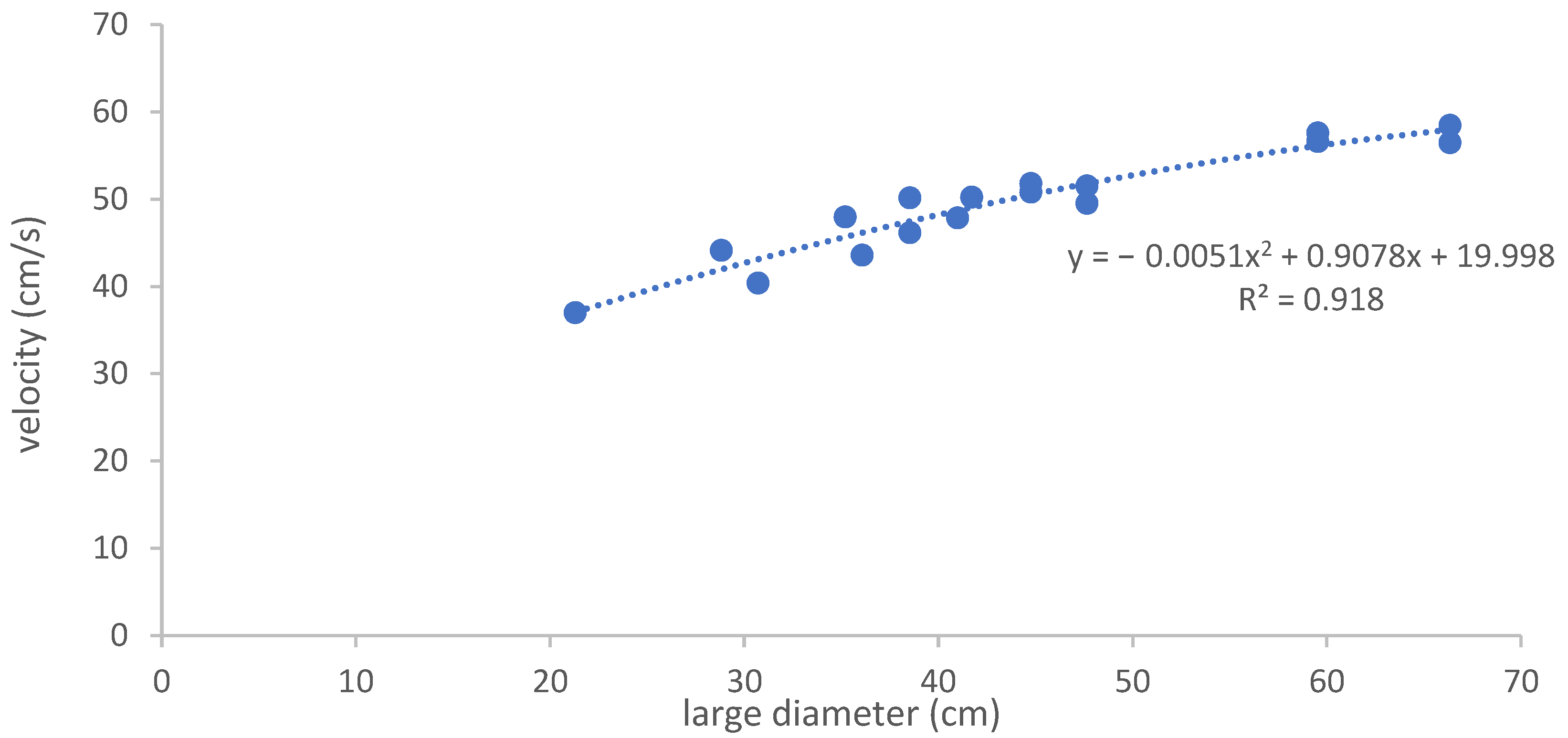

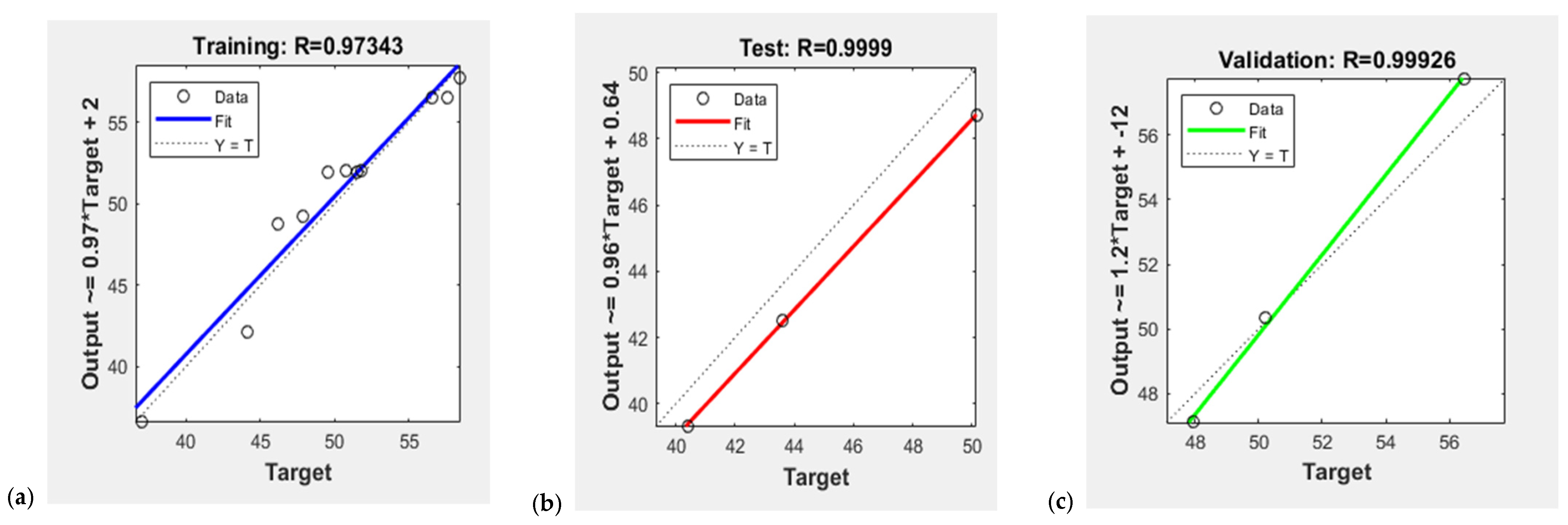
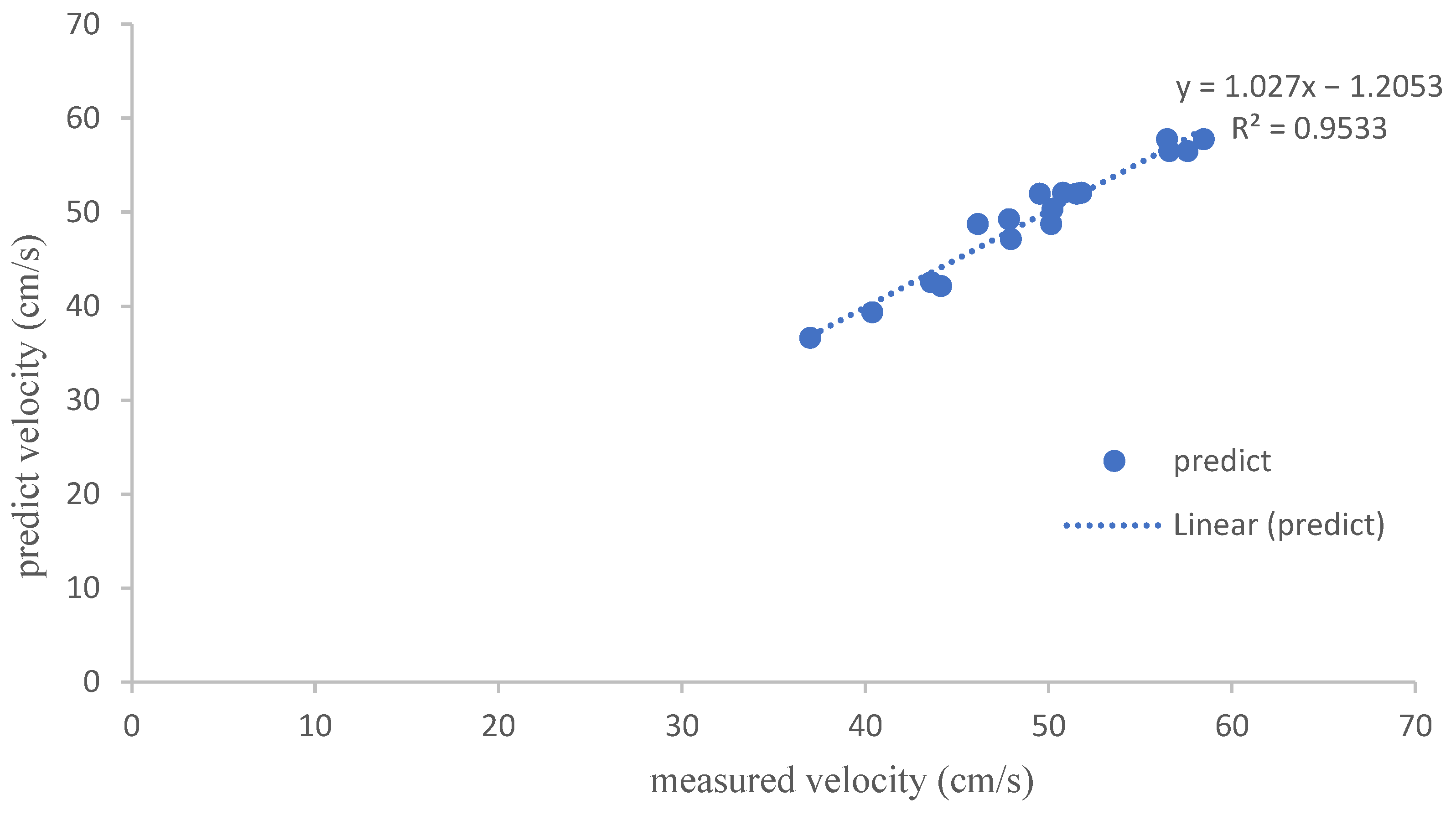

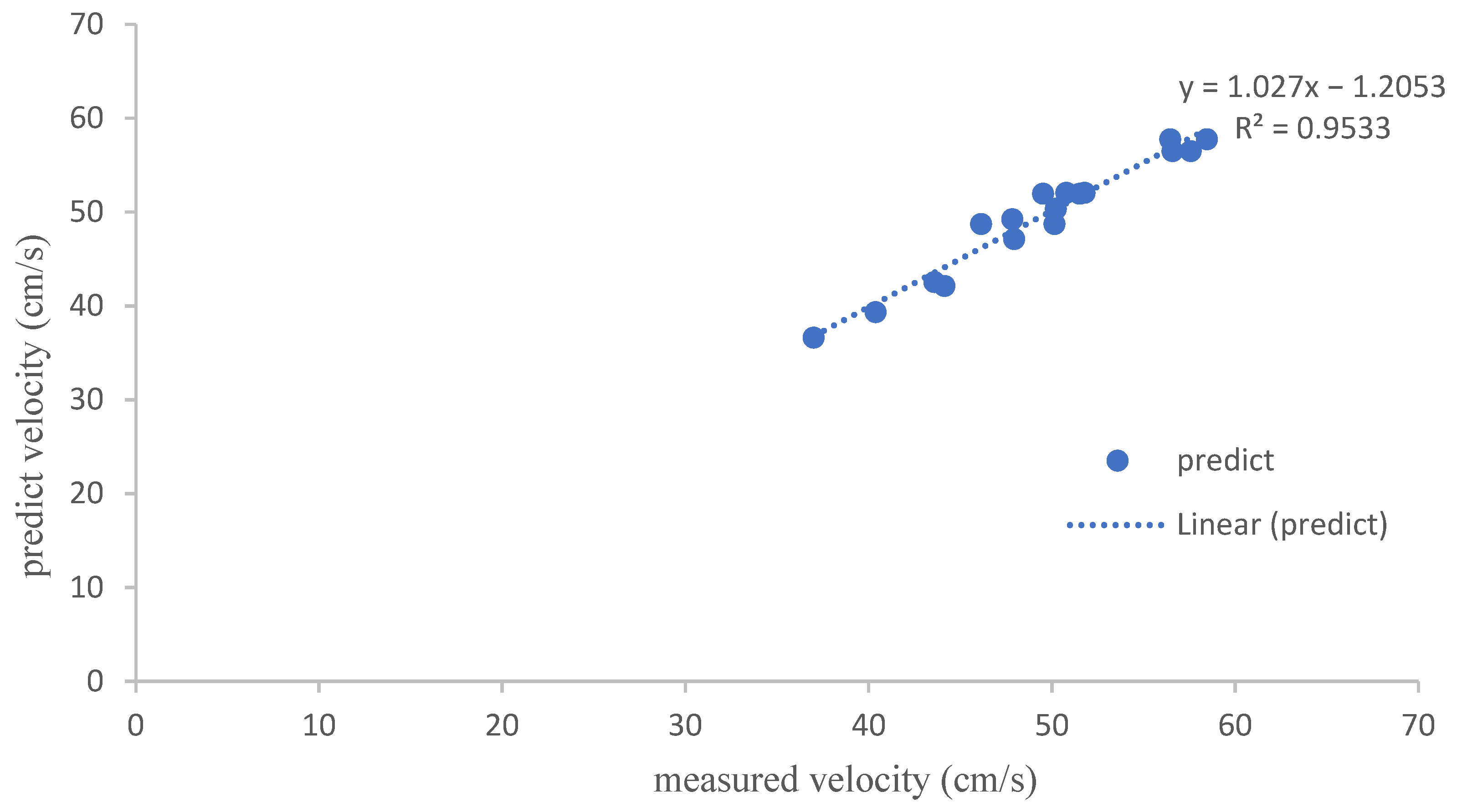
| Correlation | t | df | Std. Error | |
|---|---|---|---|---|
| Velocity (normal) and velocity (feeding) | 0.91 ** | −20.71 ** | 14 | 0.76 |
| Dmax (normal) and Dmax (feeding) | 0.95 ** | −15.75 ** | 14 | 1.3 |
| Max Diameter | Min Diameter | Velocity | Surface Center | Equivalent Diameter | |
|---|---|---|---|---|---|
| Max diameter | 1 | ||||
| Min diameter | 0.89 ** | 1 | |||
| Velocity | 0.92 ** | 0.84 ** | 1 | ||
| Surface center | 0.85 ** | 0.98 ** | 0.82 ** | 1 | |
| Equivalent diameter | 0.90 ** | 0.96 ** | 0.85 ** | 0.99 ** | 1 |
| Max Diameter | Min Diameter | Velocity | Surface Center | Equivalent Diameter | |
|---|---|---|---|---|---|
| Max diameter | 1 | ||||
| Min diameter | 0.97 ** | 1 | |||
| Velocity | 0.98 * | 0.95 ** | 1 | ||
| Surface center | 0.93 ** | 0.98 ** | 0.91 ** | 1 | |
| Equivalent diameter | 0.96 ** | 0.97 ** | 0.94 ** | 0.96 ** | 1 |
| True Positives (TP) (%) | True Negatives (TN) (%) | False Positives (FP) (%) | False Negatives (FN) (%) | |
|---|---|---|---|---|
| 100 | 100 | 0 | 0 | |
| Precision | ||||
| Recall | ||||
| FDR | ||||
| Fmeasure | ||||
| Accuracy | ||||
| The Number of Neurons | Evaluation | R | MSE | R2 |
|---|---|---|---|---|
| Train | 0.98 | 0.66 | 0.96 | |
| 1 | Test | 0.99 | 5.29 | 0.98 |
| Validation | 0.99 | 0.72 | 0.98 | |
| Train | 0.97 | 2.68 | 0.94 | |
| 2 | Test | 0.99 | 2.84 | 0.98 |
| Validation | 0.89 | 2.55 | 0.79 | |
| Train | 0.97 | 1.98 | 0.94 | |
| 3 | Test | 0.99 | 0.78 | 0.98 |
| Validation | 0.99 | 1.4 | 0.98 | |
| Train | 0.89 | 7.93 | 0.79 | |
| 4 | Test | 0.99 | 0.27 | 0.98 |
| Validation | 0.98 | 3.7 | 0.96 | |
| Train | 0.98 | 0.70 | 0.96 | |
| 5 | Test | 0.90 | 14.4 | 0.81 |
| Validation | 0.99 | 0.45 | 0.98 | |
| Train | 0.98 | 0.48 | 0.96 | |
| 6 | Test | 0.96 | 7.25 | 0.92 |
| Validation | 0.99 | 13.55 | 0.98 | |
| Train | 0.99 | 0.39 | 0.98 | |
| 7 | Test | 0.95 | 4.59 | 0.90 |
| Validation | −0.05 | 2.80 | 0.0025 |
| The Number of Neurons | Evaluation | R-Validation | MSE | R2 |
|---|---|---|---|---|
| Train | 0.97 | 15.04 | 0.94 | |
| 1 | Test | 0.98 | 18.47 | 0.96 |
| Validation | 0.99 | 2.52 | 0.98 | |
| Train | 0.97 | 2.83 | 0.94 | |
| 2 | Test | 0.98 | 10.97 | 0.96 |
| Validation | 0 | 86.19 | 0 | |
| Train | 0.99 | 0.97 | 0.98 | |
| 3 | Test | 0.99 | 6.14 | 0.98 |
| Validation | 0.99 | 0.14 | 0.98 | |
| Train | 0.82 | 38.32 | 0.67 | |
| 4 | Test | 0.98 | 10.53 | 0.96 |
| Validation | 0.99 | 1 | 0.98 | |
| Train | 0.72 | 23.03 | 0.51 | |
| 5 | Test | 0.98 | 7.69 | 0.96 |
| Validation | 0.99 | 21.09 | 0.98 | |
| Train | 0.63 | 45.81 | 0.39 | |
| 6 | Test | 0.98 | 54.28 | 0.96 |
| Validation | 0.99 | 4.30 | 0.98 | |
| Train | 0.99 | 0.69 | 0.98 | |
| 7 | Test | 0.99 | 5.43 | 0.98 |
| Validation | 0.98 | 127.41 | 0.96 |
Disclaimer/Publisher’s Note: The statements, opinions and data contained in all publications are solely those of the individual author(s) and contributor(s) and not of MDPI and/or the editor(s). MDPI and/or the editor(s) disclaim responsibility for any injury to people or property resulting from any ideas, methods, instructions or products referred to in the content. |
© 2023 by the authors. Licensee MDPI, Basel, Switzerland. This article is an open access article distributed under the terms and conditions of the Creative Commons Attribution (CC BY) license (https://creativecommons.org/licenses/by/4.0/).
Share and Cite
Behzadi Pour, F.; Parra, L.; Lloret, J.; Abdanan Mehdizadeh, S. Measuring and Evaluating the Speed and the Physical Characteristics of Fishes Based on Video Processing. Water 2023, 15, 2138. https://doi.org/10.3390/w15112138
Behzadi Pour F, Parra L, Lloret J, Abdanan Mehdizadeh S. Measuring and Evaluating the Speed and the Physical Characteristics of Fishes Based on Video Processing. Water. 2023; 15(11):2138. https://doi.org/10.3390/w15112138
Chicago/Turabian StyleBehzadi Pour, Faezeh, Lorena Parra, Jaime Lloret, and Saman Abdanan Mehdizadeh. 2023. "Measuring and Evaluating the Speed and the Physical Characteristics of Fishes Based on Video Processing" Water 15, no. 11: 2138. https://doi.org/10.3390/w15112138
APA StyleBehzadi Pour, F., Parra, L., Lloret, J., & Abdanan Mehdizadeh, S. (2023). Measuring and Evaluating the Speed and the Physical Characteristics of Fishes Based on Video Processing. Water, 15(11), 2138. https://doi.org/10.3390/w15112138








